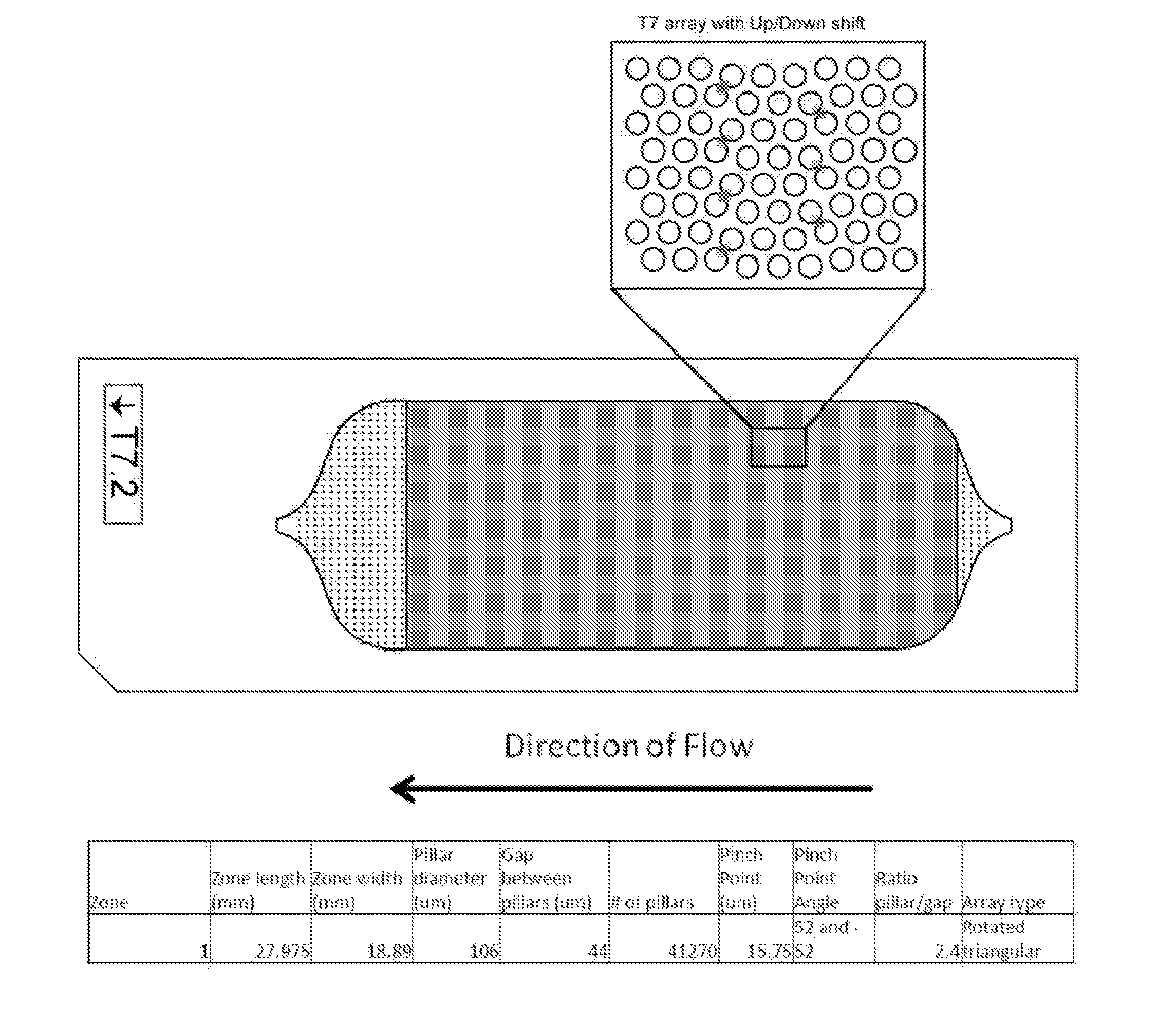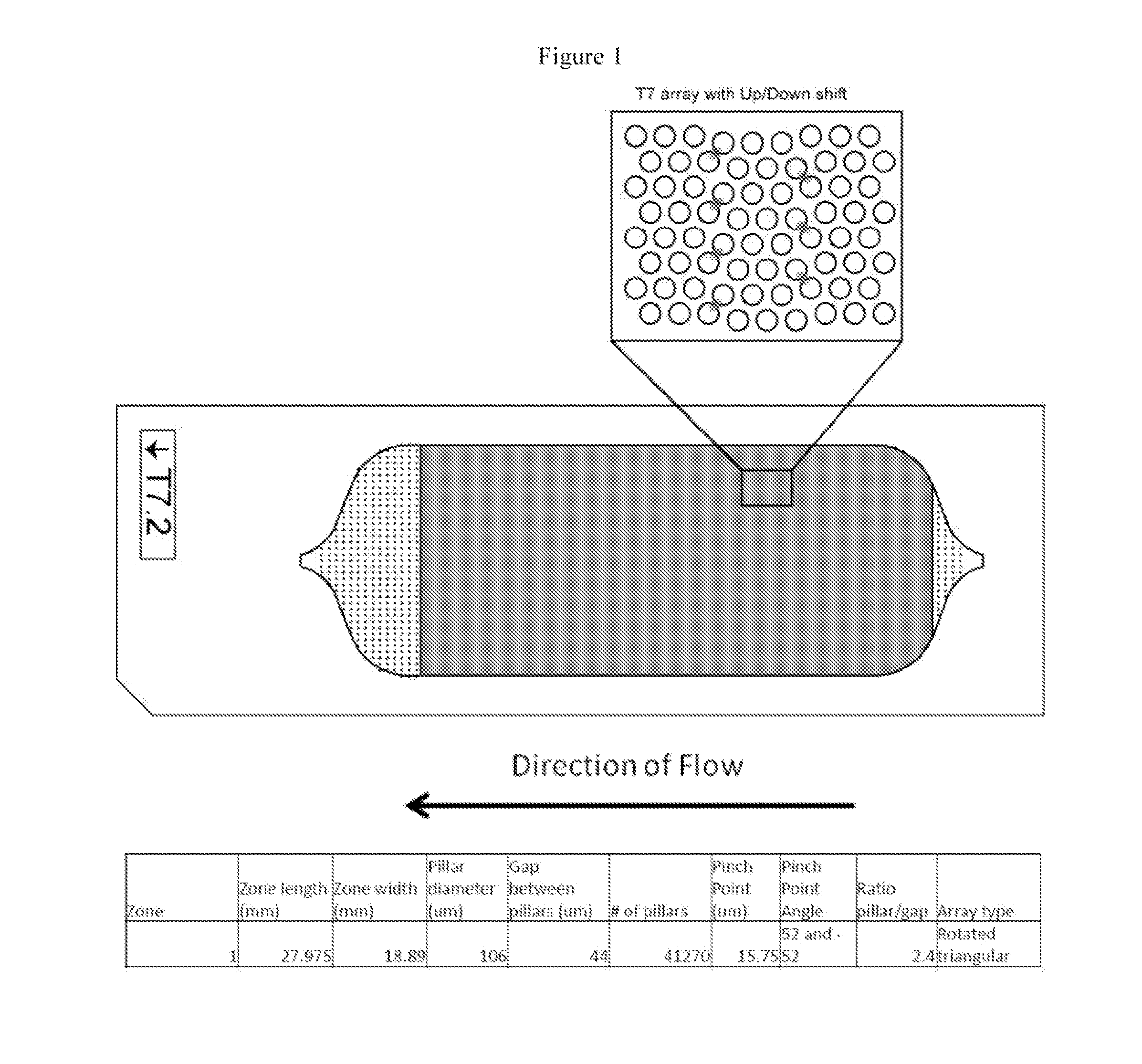Circulating tumor cell capture on a microfluidic chip incorporating both affinity and size
a microfluidic chip and tumor cell technology, applied in the field of medical diagnostics and microfluidics, can solve the problems of many cancers going undetected and damaging healthy tissue, and achieve the effects of high hydrophilicity, minimal damage, and maximum flexibility/solubility and activity
- Summary
- Abstract
- Description
- Claims
- Application Information
AI Technical Summary
Benefits of technology
Problems solved by technology
Method used
Image
Examples
example 1
Viable Cell Capture
[0287]Prostate tumor cell lines, PC-3, were grown in vitro, and cells were spiked into normal patient blood. The blood was run on a microfluidic device. Instead of fixation, RPMI-1640 cell culture growth medium was added to the chip and the entire chip was then incubated at 37° C. After 1.5 weeks, growing colonies of cells were visible on the surface of the posts (FIG. 32). The ability of the devices to capture viable cells allowed for additional molecular characterization unavailable with platforms that fix the cells prior to capture.
[0288]In another experiment, mouse xenograft blood was run across a microfluidic device, washed, the sealing tape removed, and the chip placed in a tissue culture dish in RPMI 1640 / 10% FBS / penicillin-streptomycin under 5.0% CO2. Cells were imaged by fluorescence and phase-contrast microscopy. At termination of the incubation period, Hoechst 33342 and propidium iodide were added to visualize nuclei and identify dead cells respectively...
example 2
Functionalization of Microfluidic Devices
[0290]Microfluidic devices were cleaned and activated with oxygen plasma, incubated with 4% 11-(succinimidyloxy)undecycldimethylethoxysilane (Gelest) in ethanol, washed with ethanol, incubated with 10 μg / mL NeutrAvidin (Pierce) and washed with PBS. This chemistry creates a modified plastic surface amenable to attachment of biomolecules using the avidin-biotin associations. Alternatively, the oxidized chips can be incubated with short dextran chains. Following initial chemical activation, the chips were incubated with 10 μg / ml of a mouse monoclonal anti-EpCAM antibody. Additional other tumor antigen antibodies have been applied at this step as well. Unbound antibodies were washed out prior to processing into storage buffers. The microfluidic device surfaces were stored in a stabilized form by protecting the functionalized microfluidic device batches with a sugar buffer. Many medical devices use a number of sugar-based buffers to stabilize anti...
example 3
Method to Functionalize a Binding Moiety to the Obstacles
[0291]The substrate of a microfluidic device was rinsed twice in distilled, deionized water and allowed to air dry. Silane immobilization onto exposed glass was performed by immersing samples for 30 seconds in freshly prepared, 2% v / v solution of 3-[(2 aminoethyl)amino]propyltrimethoxysilane in water followed by further washing in distilled, deionized water. The substrate was then dried in nitrogen gas and baked. Next, the substrate was immersed in 2.5% v / v solution of glutaraldehyde in phosphate buffered saline for 1 hour at ambient temperature. The substrate was then rinsed again, and immersed in a solution of 0.5 mg / mL binding moiety, for example, anti-EpCAM, anti-CD71, anti-CD36, anti-GPA, or anti-CD45, in distilled, deionized water for 15 minutes at ambient temperature to couple the binding agent to the obstacles. The substrate is then rinsed twice in distilled, deionized water, and soaked overnight in 70% ethanol for ste...
PUM
 Login to View More
Login to View More Abstract
Description
Claims
Application Information
 Login to View More
Login to View More - R&D
- Intellectual Property
- Life Sciences
- Materials
- Tech Scout
- Unparalleled Data Quality
- Higher Quality Content
- 60% Fewer Hallucinations
Browse by: Latest US Patents, China's latest patents, Technical Efficacy Thesaurus, Application Domain, Technology Topic, Popular Technical Reports.
© 2025 PatSnap. All rights reserved.Legal|Privacy policy|Modern Slavery Act Transparency Statement|Sitemap|About US| Contact US: help@patsnap.com



